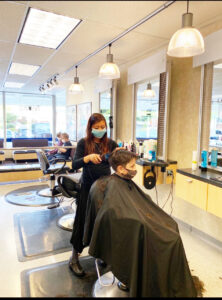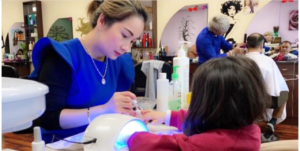
Northwest Vietnamese News
Neon signage advertising lush comb-overs and immaculate manicures, early 2000 hair model portraits and customers sitting in a row of folding chairs are familiar sights for many in the South Seattle neighborhoods. Nail and hair salons have been a cornerstone of the Vietnamese-American business community, dotting streets and corners of Little Saigon across the nation and at home in Seattle. There are about 2,180 Vietnamese owned nail and hair salons across the state, making up around 60% of salon ownership.
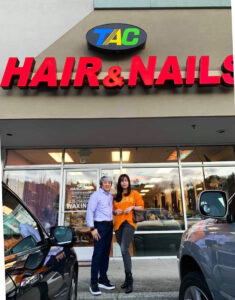
For many new immigrants from Vietnam, working in a nail salon is a first step in establishing a sense of financial stability and connecting with ethnic enclaves. However, with the advent of the COVID-19 pandemic, salon workers are facing disproportionate health risks and uncertain futures. On the heels of reopening, workers are having to contend with a rush of new clients, exposing them to an illness that many cannot afford to stay home and grapple with.
But before the pandemic, finding customers or revenue weren’t struggles for these salons. “There were a lot of customers and business was going well before the virus. I didn’t find any trouble getting manicure clients and had a lot of regulars” said Nancy, who has been working in a nail salon for 8 years. “It was a long struggle and I had to jump around working with a lot of salons, but I finally managed to get my own salon and it’s been running for 15 years. It wasn’t easy navigating all the contracts and legal documents by myself,” said a hair salon owner who immigrated from Vietnam in 1993. “I had actually expanded to California this year after owning a couple in Washington for over 10 years. It was really exciting but the pandemic threw a wrench in everything.” said Trang – TAC – another local salon owner. It’s no wonder that the imminent closure of salons represented a major disruption.
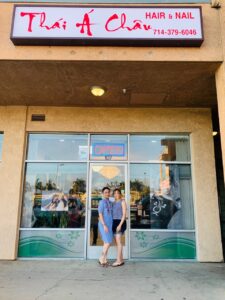
Although Governor Jay Inslee’s closure of restaurants, entertainment facilities and salons landed on March 16th, many Vietnamese-owned salons had been keeping up with outbreak updates through social media outlets since late 2019. As the virus claimed an accelerating number of resources and lives in the US, many grew less optimistic of the public health response. “I was pessimistic about what could happen next for this virus, but tried to remain focused on the task at hand and pay the bills waiting at home. I couldn’t afford not to show up to work” an anonymous nail salon worker stated. Their salon and many others like it started implementing their own safety regulations ahead of official mandates, including requiring masks, sanitizing seats and switching to appointment-only visits.
Salons then reopened with Phase 1.5 on June 5th with a number of restrictions and safety protocols. “The owner follows the regulations really strictly and is pretty well-stocked with PPE. Wearing a mask is sometimes bothersome and hard to breathe in for a whole day of work, but there really isn’t any choice I have in the manner” said an anonymous nail salon worker. For salons that had implemented regulations beforehand, not much changed.
“I’ve completely changed the way I do hair in many ways. I’ve halved the time that I’ve cut hair, from 15 to 7 minutes. I’ve rotated the client so that I always cut from behind and I don’t use the blow-dryer for fear that I’ll blow viral particles around” said another anonymous hair salon worker. Checking for masks, doing door temperature checks, rearranging spaces to ensure social distancing and limited capacity and deep cleaning surfaces became standard practice. COVID-19 serves to add to the well-documented occupational health burdens of salon workers, who disproportionately receive chronic exposures to chemical and biological hazards.
“To clean and prepare and rearrange all of this is a lot of extra work, where we don’t have the income to be compensated for. But at the end of the day it’s for the safety of the customers, coworkers and for myself.” said an anonymous nail salon worker.
These necessary measures have not come cheaply and have added an additional financial and labor strain on businesses already suffering from damaging lost revenue. “Buying PPE is expensive. Cleaning everything is expensive. And I know a lot of my workers are going to call out because they’re worried. I’m still going to pay them in full. Just know that these expenses are all coming in when there’s no revenue.” said an anonymous salon owner. The City of Seattle’s small business grant financing has alleviated some pressure on small businesses, but those benefits aren’t able to reach everyone in need and may not cover the full cost of previous closures.
The impact of COVID-19 has unearthed major fragilities in small business support systems and may be far from over. Washington State has so far done an admirable job of flattening the curve but officials have constantly warned about complacency. Their warnings have come into light as King County has experienced some of the highest daily rises of COVID cases throughout June. This reopening poses greater risks for service workers, and has many reaching a bleak conclusion about the future of their industry. “I actually think larger, more established salons will struggle, as their costs are higher.” said Trang – TAC. “Small businesses will maybe survive, but for those that are too small, the eventual lack of customers will get to them.”
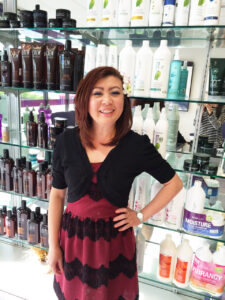 “This job pays the bills for the time being. But I can’t see myself in this line of work forever. The economy will be in shambles with another wave of the virus and a lot more people will be out of work,” said Nancy. She plans to pursue a medical assistant degree and take advantage of the growing demand for healthcare workers. “I want to be able to provide a long-term future for my family, and I have to start that process now. I know many coworkers who are older and don’t have the resources to do a career change like this.” The phrase “uncertain times” has been locked into our vocabulary and for many of these salon workers, it exemplifies their situation with the looming threat of a second wave of COVID-19 outbreaks predicted by the CDC.
“This job pays the bills for the time being. But I can’t see myself in this line of work forever. The economy will be in shambles with another wave of the virus and a lot more people will be out of work,” said Nancy. She plans to pursue a medical assistant degree and take advantage of the growing demand for healthcare workers. “I want to be able to provide a long-term future for my family, and I have to start that process now. I know many coworkers who are older and don’t have the resources to do a career change like this.” The phrase “uncertain times” has been locked into our vocabulary and for many of these salon workers, it exemplifies their situation with the looming threat of a second wave of COVID-19 outbreaks predicted by the CDC.
“Some of my nail clients are giving bigger tips and pre-paying for their appointments, and they’re my regulars who understand how hard of a time I’m having. But I can’t live off of that kindness forever. I need to re-evaluate whether continuing to work here is worth it,” said Nancy.
Jeff Nguyen – Northwest Vietnamese News
This article was made possible thanks to support from Facebook

